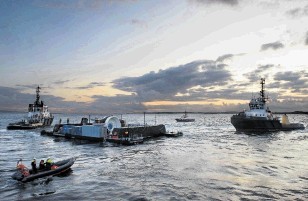
Developers of marine energy devices are expected to benefit from a new Scottish collaboration to help reduce the risk and cost of testing.
FloWave TT and the European Marine Energy Centre (Emec) have agreed to share data collected at Emec’s wave and tidal test sites in Orkney.
This data will allow FloWave to replicate at scale the actual sea conditions off Orkney in its £9.5million onshore test centre, which will be completed next year at Edinburgh University’s King’s Buildings campus.
In-tank simulation of the site-specific conditions found at Emec will allow developers to hone their marine energy ideas and concepts quickly and cheaply at a smaller scale, before deploying their devices in the sea.
FloWave chief executive Stuart Brown said: “By bringing the real sea into the lab, developers will be able to test robustness and performance against the exact conditions seen at Emec, as well as practice deployments.
“They can also quickly and easily simulate extreme storm events in a calculated and controlled manner. This will allow them to improve their designs before they are deployed, rather than waste valuable time at sea working out the gremlins.”
For Emec, the new agreement means that developers will have more refined devices to bring to site, allowing its berths to be used more efficiently.
Emec managing director Neil Kermode said: “At times I’ve wished I could turn off the tides and waves at the full-scale sites and reset things, and this is exactly what developers will be able to do at FloWave, making device development much quicker and easier.”
The collaboration will see Emec sharing 10 years of data collected from buoys and other instrumentation deployed at the Orkney test sites.
The FloWave team will then work with Emec engineers and scientists to turn this recorded data into an instruction set, allowing those conditions to be replicated in the test tank.
The FloWave centre – funded by the Engineering and Physical Sciences Research Council and the university – will comprise a circular pool, able to simulate combinations of waves and currents at up to one-tenth scale for normal, challenging and extreme conditions of coastlines around Europe.
Recommended for you
